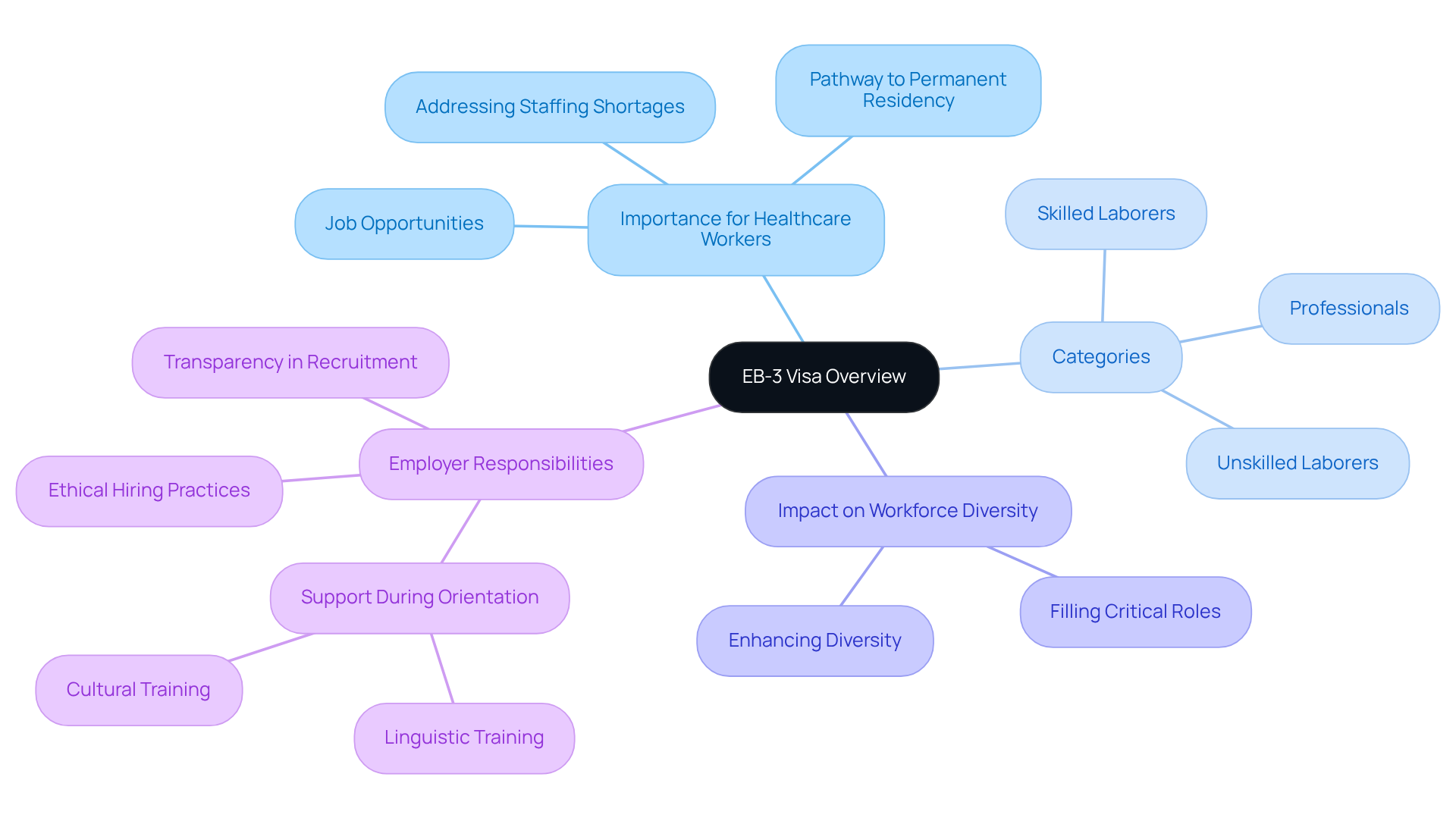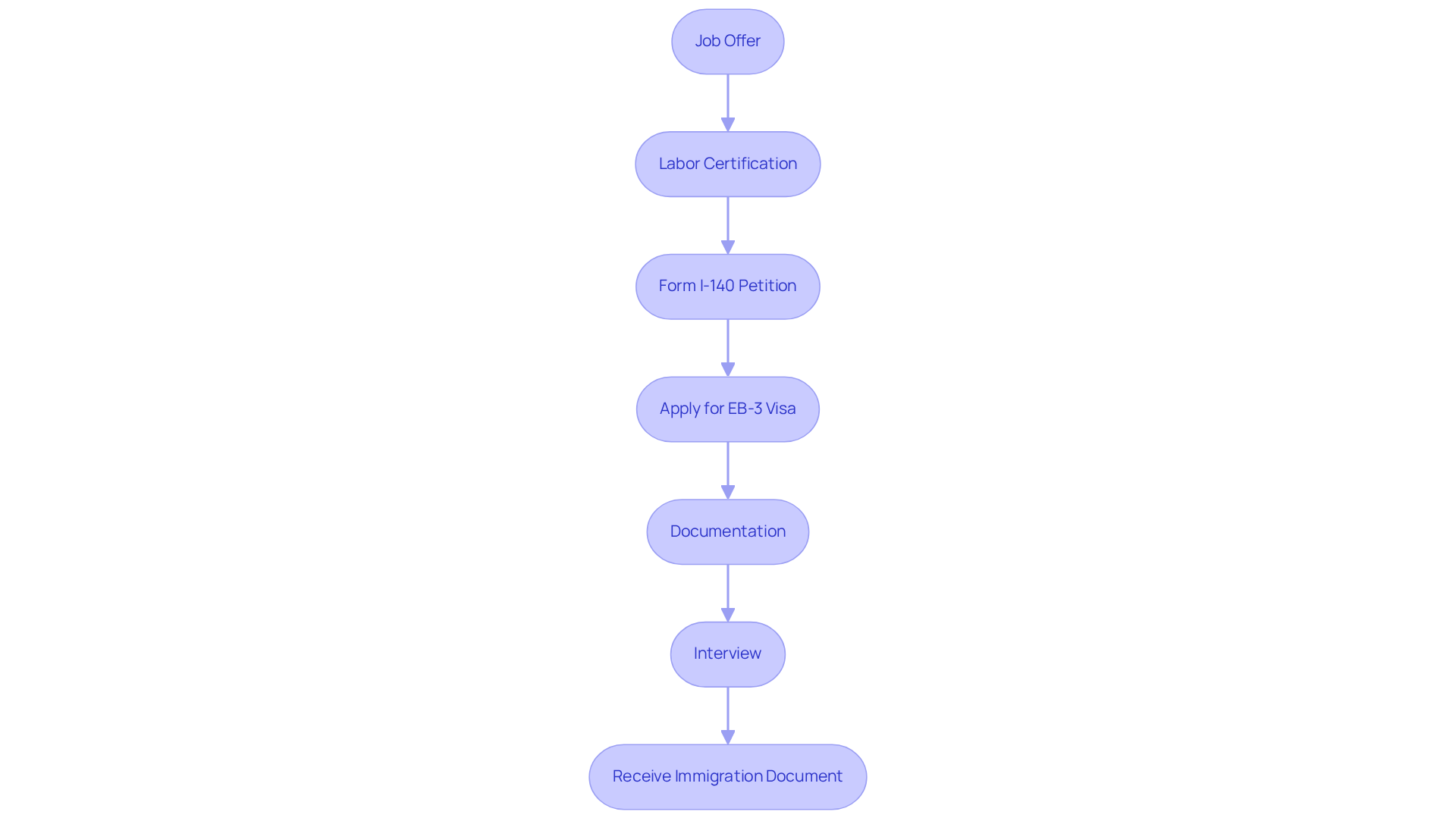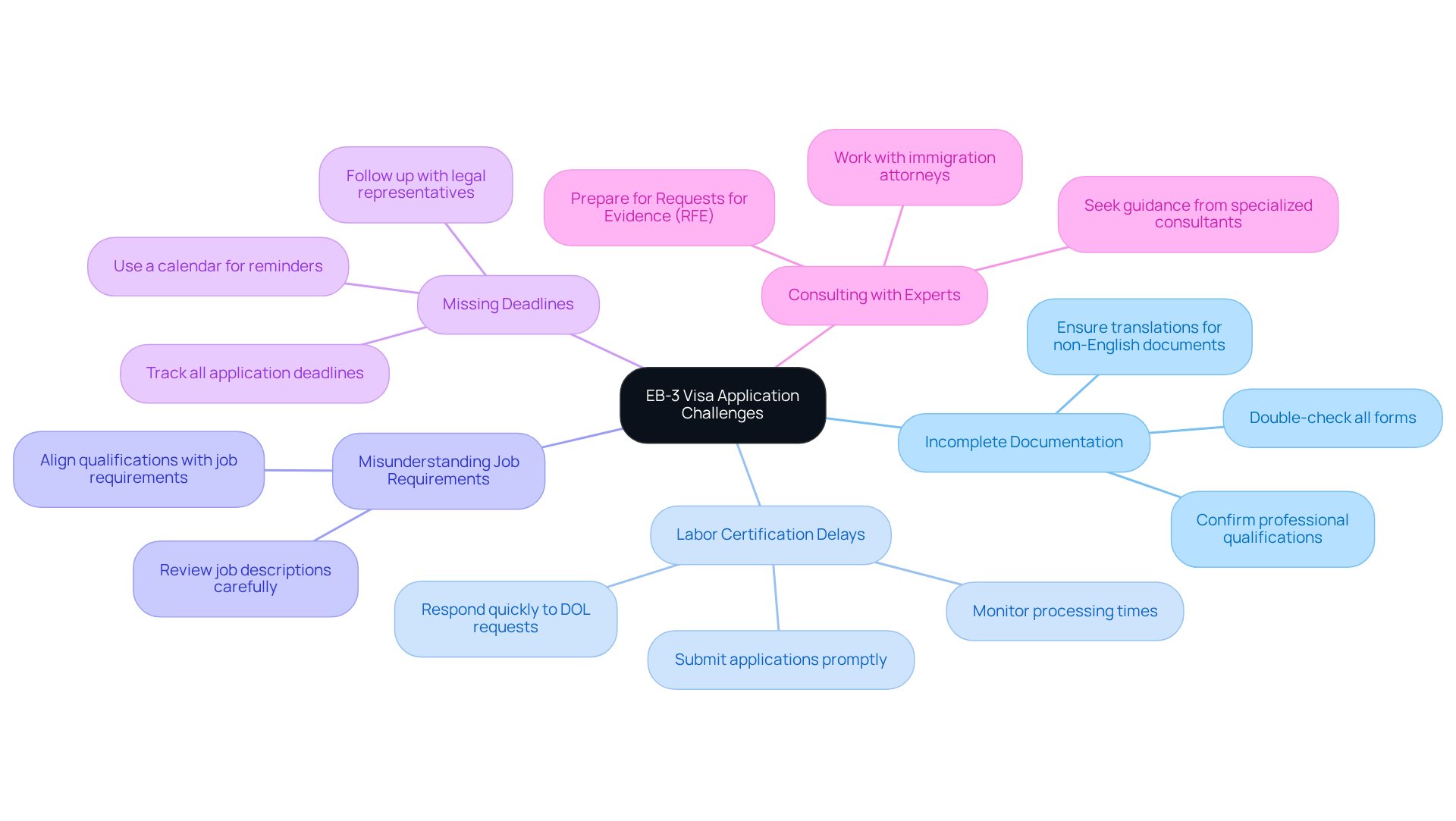Overview
The EB-3 visa is crucial for immigrant healthcare workers, offering a vital pathway to permanent residency in the United States. This visa addresses the pressing demand for medical services, ensuring that qualified professionals can fill critical roles in our healthcare system.
Have you ever felt overwhelmed by the immigration process? You're not alone. This article outlines the eligibility criteria, application process, and common challenges, providing clear solutions rooted in expertise and compassion.
Securing this visa not only opens doors to job opportunities but also strengthens the U.S. healthcare system. Remember, we’re in this fight with you—your future matters to us.
Introduction
The EB-3 visa stands as a crucial gateway for immigrant healthcare workers striving for permanent residency in the United States, a nation facing a significant demand for medical professionals.
Have you ever felt overwhelmed by the immigration process? This article explores the essential steps for navigating the EB-3 visa application process, providing vital insights into eligibility criteria, documentation requirements, and common pitfalls to avoid.
As the immigration landscape evolves and competition grows, what strategies can healthcare professionals employ to ensure their applications stand out and succeed?
Remember, you’re not alone in this fight—we’re here to guide you every step of the way.
Overview of the EB-3 Visa and Its Importance for Immigrant Healthcare Workers
The employment-based immigrant permit is a vital tool that empowers foreign individuals to secure permanent residency in the United States. This permit is particularly crucial for immigrant medical professionals, such as nurses and allied health practitioners, as it addresses the growing demand for medical services across the country. The employment-based immigration permit is categorized into three sections: skilled laborers, professionals, and unskilled laborers, accommodating a diverse range of medical roles.
For medical practitioners, obtaining an EB-3 visa not only opens doors to immediate job opportunities but also lays the groundwork for permanent residency and eventual citizenship. This pathway is essential for those looking to build a long-term future within the U.S. medical system. Recent trends indicate a rising demand for employment-based immigration permits, evidenced by the early depletion of available permits for FY 2024. This highlights the critical role these professionals play in our workforce.
Consider how the employment-based third preference positively impacts staffing in the medical field. Medical employers who actively engage in the application process can significantly enhance their workforce diversity and address staffing shortages. Additionally, the ethical responsibilities of employers in hiring foreign-educated health professionals are paramount. They must ensure a discrimination-free environment and provide the necessary support during clinical orientation.
Industry leaders emphasize the importance of the EB-3 visa in filling crucial positions within the U.S. medical system. As the landscape of immigration evolves, this category remains essential for skilled medical professionals dedicated to improving the well-being of communities throughout the United States. Remember, you are not alone in this journey; we’re here to fight for you and your future.

Eligibility Criteria for the EB-3 Visa: Skilled, Professional, and Unskilled Workers
To qualify for the EB-3 visa, applicants must meet the criteria of one of three categories:
-
Skilled Workers: Applicants must have at least two years of training or experience in a skilled occupation. This is particularly relevant for healthcare professionals who have completed the necessary education and training, such as physical therapists and medical technicians. Moreover, a labor certification is crucial to demonstrate that there are no qualified U.S. individuals available for the position in order to qualify for an EB-3 visa.
-
Professionals: This category requires applicants to possess a U.S. bachelor's degree or its foreign equivalent. Healthcare professionals, including registered nurses and pharmacists, typically qualify under this category, as their roles necessitate a degree. Like skilled workers, they must also provide a labor certification.
-
Unskilled Workers: Applicants in this category must be capable of performing unskilled labor that requires less than two years of training. While less common for healthcare professionals, this may apply to certain support roles, such as nursing assistants or home health aides. A labor certification is also necessary for this category.
Each category for the EB-3 visa has specific documentation requirements that must be fulfilled to demonstrate eligibility, including proof of education, training, and job offers from U.S. employers. We understand how overwhelming this process can be, especially with yearly restrictions for employment-based third preference categories resetting on October 1, 2025. This change will impact the accessibility of permits for applicants. Currently, all accessible immigrant permits in the third employment-based category for fiscal year 2025 have been distributed, indicating no additional permits will be granted until the new fiscal year starts. Remember, you don’t have to navigate this alone—we’re here to fight for your family.

Step-by-Step Application Process for the EB-3 Visa: Documentation and Procedures
Navigating the application process for the EB-3 visa can feel overwhelming, but understanding the essential steps can empower you to move forward with confidence:
-
Job Offer: First, you need a job offer from a U.S. employer willing to sponsor your visa application. This is your starting point.
-
Labor Certification: Your employer must submit a Labor Certification application to the U.S. Department of Labor (DOL). This step demonstrates that there are no qualified individuals from the U.S. available for the position. It’s especially critical for experienced and professional individuals, particularly in the medical field, where approval rates can significantly impact your timeline and success. Recent statistics show high approval rates for healthcare positions, reflecting the strong demand for skilled workers in this sector.
-
Form I-140 Petition: Once the Labor Certification is approved, your employer will file Form I-140, Immigrant Petition for Alien Worker, on your behalf. This form is vital as it determines your qualification for the employment-based third preference.
-
After the I-140 petition is approved, you can apply for the EB-3 visa through either consular processing or adjustment of status, depending on your location.
-
Documentation: Gather and submit various documents, including proof of qualifications, employment verification, and personal identification. This documentation is crucial for demonstrating your eligibility and should be meticulously organized. Specific documents may include diplomas, licenses, and letters of recommendation.
-
Interview: In some cases, you may be required to attend an interview at a U.S. consulate or embassy. Here, you’ll discuss your qualifications and intentions in the U.S. Preparing for this interview is essential, as it can influence the final decision regarding your application.
-
If you complete all steps successfully, you will receive your employment-based immigration document, allowing you to enter the U.S. as a permanent resident. It’s important to stay informed about the current landscape of permit availability, as all employment-based third preference and EW permits for FY 2025 have been issued. Understanding the nuances of the application procedures can significantly enhance your chances of a favorable outcome, especially for healthcare professionals navigating this complex process. Seeking insights from immigration experts can also provide valuable guidance throughout this journey. Remember, you’re not alone in this fight—we’re here to support you every step of the way.

Common Challenges and Mistakes in the EB-3 Visa Application: Tips for Success
Navigating the employment-based third preference application process can be overwhelming. Many applicants face common pitfalls, but with the right strategies, success is within reach.
-
Incomplete Documentation: One frequent mistake is submitting incomplete or inaccurate documentation. Gather all required documents and double-check for accuracy before submission. Minor errors can lead to significant setbacks, so a thorough review is essential.
-
Labor Certification Delays: Delays in obtaining Labor Certification can hinder your application. Employers should proactively manage the PERM Labor Certification process by submitting applications promptly and responding quickly to any requests from the Department of Labor (DOL). With processing times often exceeding 36 months, timely action is crucial to avoid complications.
-
Misunderstanding Job Requirements: It’s vital to clearly understand the job requirements specified in the Labor Certification. Ensure your qualifications align with these requirements to prevent complications. Accurate job descriptions are essential to demonstrate that no qualified U.S. workers are available for the position.
-
Missing Deadlines: Keep track of all deadlines associated with the application process. Missing a deadline can result in delays or denials. Mark key due dates on a calendar, regularly follow up with your legal representatives, and keep copies of all correspondence with USCIS to stay on track.
-
Consulting with Experts: Consider working with an immigration attorney or specialized immigration consultants, like those at AgoraVisa, who can provide tailored assistance. Their guidance can help navigate complex regulations and improve your chances of a successful application. Professional assistance is particularly beneficial when preparing responses to Requests for Evidence (RFE) and ensuring comprehensive documentation.
By being aware of these challenges and taking proactive steps, you can significantly enhance your likelihood of successfully obtaining an eb-3 visa. Remember, you’re not alone in this fight—together, we can navigate the complexities ahead.

Conclusion
The EB-3 visa stands as a crucial opportunity for immigrant healthcare workers eager to build their lives and careers in the United States. This employment-based visa not only opens doors to immediate job opportunities but also lays the foundation for permanent residency and citizenship. With the rising demand for healthcare professionals, grasping the intricacies of the EB-3 visa is essential for those who wish to make a significant impact in the U.S. medical system.
Throughout this article, we delved into vital aspects of the EB-3 visa, including:
- Eligibility criteria for skilled, professional, and unskilled workers
- The step-by-step application process
- Common challenges applicants may encounter
It is crucial to recognize that thorough documentation, timely actions, and a clear understanding of job requirements are vital for successfully navigating this complex process. Seeking expert guidance can greatly enhance your chances of a favorable outcome, ensuring you are not alone in this journey.
As the healthcare sector's needs continue to grow, the EB-3 visa emerges as an indispensable tool for both immigrant professionals and U.S. employers. By taking proactive steps and staying informed about the application process, healthcare workers can secure their future while playing a vital role in addressing staffing shortages in the medical field. Embracing this opportunity can lead to a fulfilling career and contribute to the well-being of communities nationwide. Remember, we’re here to fight for your future—Yo Peleo — We Fight.
Frequently Asked Questions
What is the EB-3 visa?
The EB-3 visa is an employment-based immigrant permit that allows foreign individuals, particularly medical professionals, to secure permanent residency in the United States.
Why is the EB-3 visa important for immigrant healthcare workers?
The EB-3 visa is crucial for immigrant healthcare workers as it addresses the growing demand for medical services in the U.S. and provides pathways to immediate job opportunities, permanent residency, and eventual citizenship.
What categories does the EB-3 visa cover?
The EB-3 visa is categorized into three sections: skilled laborers, professionals, and unskilled laborers, accommodating a diverse range of medical roles.
How does the EB-3 visa impact staffing in the medical field?
The EB-3 visa positively impacts staffing by enabling medical employers to enhance workforce diversity and address staffing shortages through the hiring of foreign-educated health professionals.
What responsibilities do employers have when hiring foreign-educated health professionals?
Employers have ethical responsibilities to ensure a discrimination-free environment and provide necessary support during clinical orientation for foreign-educated health professionals.
What recent trends have been observed regarding the EB-3 visa?
Recent trends indicate a rising demand for employment-based immigration permits, highlighted by the early depletion of available permits for FY 2024, showcasing the critical role of these professionals in the workforce.
What role do industry leaders see for the EB-3 visa in the U.S. medical system?
Industry leaders emphasize the importance of the EB-3 visa in filling crucial positions within the U.S. medical system, particularly as the landscape of immigration continues to evolve.




